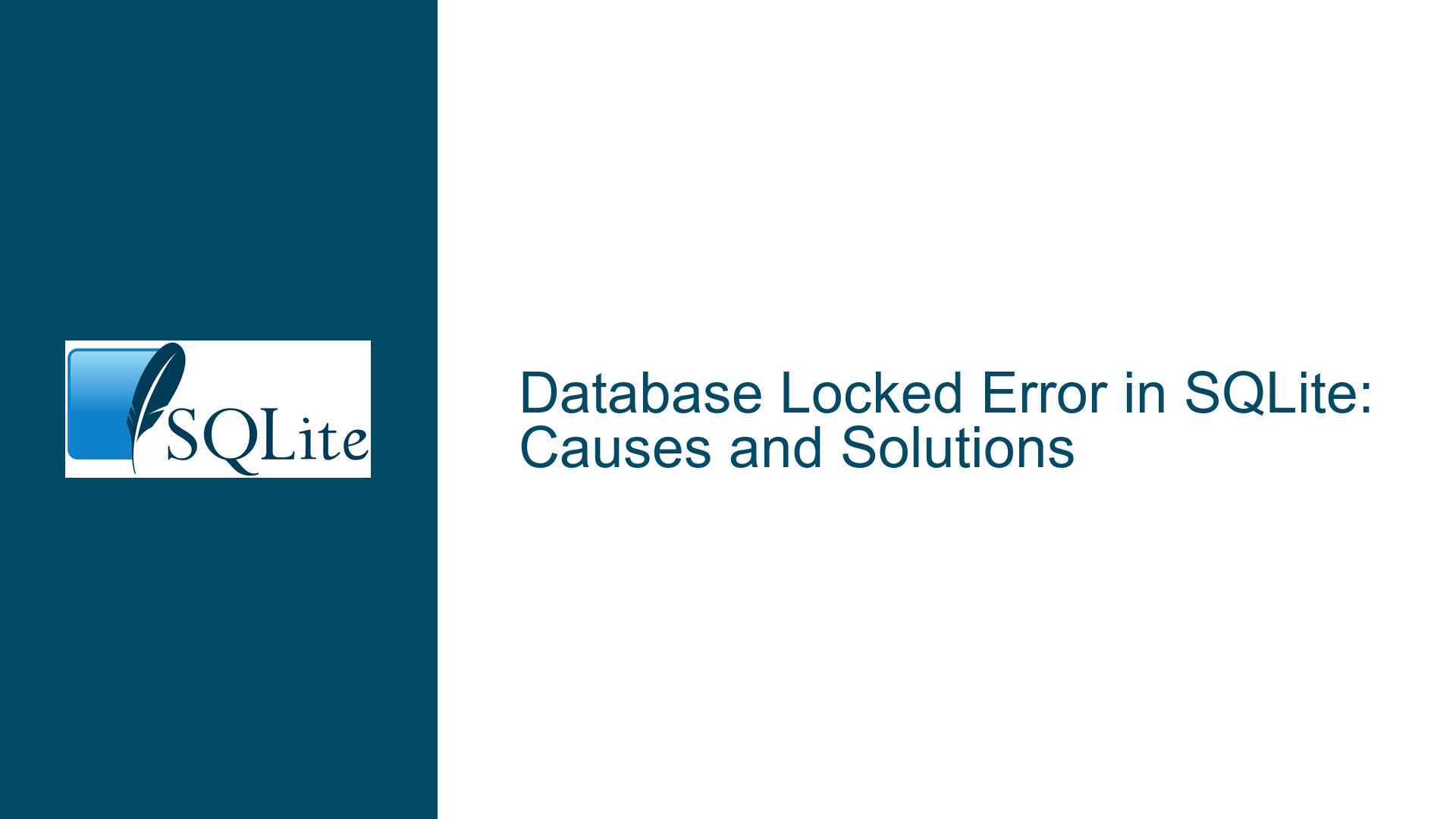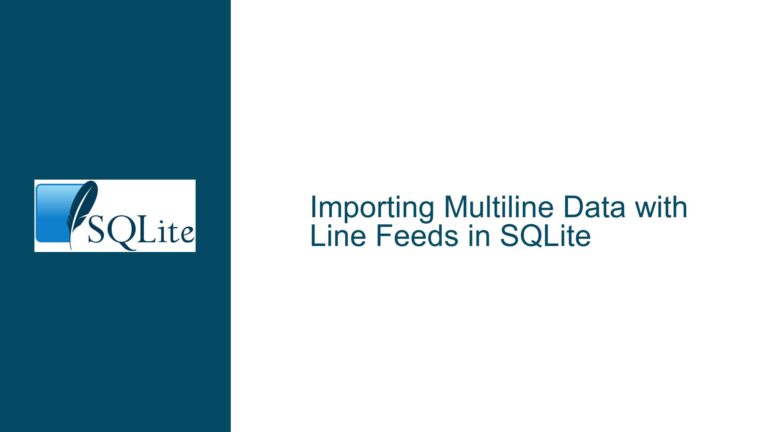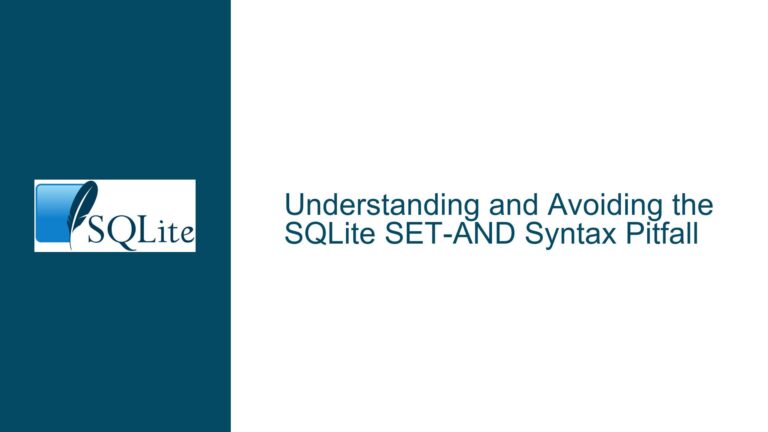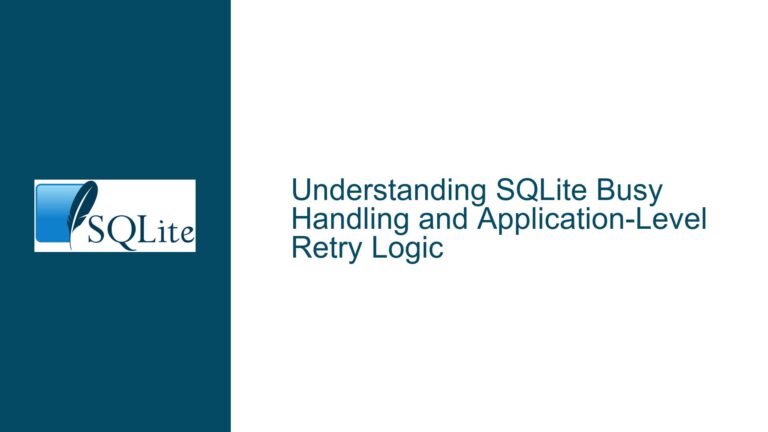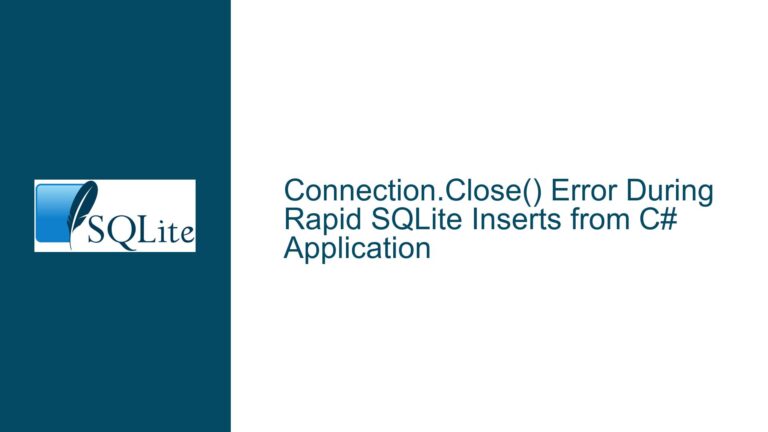Database Locked Error in SQLite: Causes and Solutions
Understanding the "Database is Locked" Error in SQLite
The "Database is Locked" error in SQLite is a common yet often misunderstood issue that can disrupt the normal operation of applications relying on SQLite databases. This error typically occurs when a database operation cannot proceed because another process or thread has locked the database, preventing further modifications or reads. The error message is straightforward, but its implications and resolutions are nuanced, requiring a deep dive into SQLite’s concurrency model, locking mechanisms, and the specific context in which the error arises.
SQLite employs a file-based locking mechanism to manage concurrent access to the database. When a process or thread attempts to write to the database, it must first acquire an exclusive lock. If another process or thread already holds a lock, the requesting process will receive the "Database is Locked" error. This locking mechanism is essential for maintaining data integrity but can lead to contention issues in high-concurrency environments or when long-running transactions are involved.
The error message provided in the discussion, Database error: database is locked: {INSERT INTO rcvfrom(uid, mtime, nonce, ipaddr)VALUES(1706, julianday('now'), NULL, '?????')}, indicates that an INSERT operation was attempted but could not proceed due to the database being locked. The julianday('now') function suggests that the operation involves timestamping, which is a common requirement in many applications. The rcvfrom table appears to be a log or tracking table, possibly used to record incoming requests or messages, with fields for user ID (uid), timestamp (mtime), a nonce (nonce), and an IP address (ipaddr).
Potential Causes of the "Database is Locked" Error
The "Database is Locked" error can arise from several underlying causes, each requiring a different approach to resolution. Understanding these causes is crucial for diagnosing and fixing the issue effectively.
1. Concurrent Access and Write Contention: One of the most common causes of the "Database is Locked" error is concurrent access to the database by multiple processes or threads. SQLite uses a file-based locking mechanism, which means that only one process or thread can hold an exclusive lock at any given time. If multiple processes or threads attempt to write to the database simultaneously, contention can occur, leading to the "Database is Locked" error. This is particularly common in web applications where multiple users or requests may be accessing the database concurrently.
2. Long-Running Transactions: Another potential cause of the "Database is Locked" error is long-running transactions. When a transaction is open, SQLite holds locks on the database to ensure data integrity. If a transaction remains open for an extended period, it can block other processes or threads from acquiring the necessary locks, leading to the "Database is Locked" error. This is especially problematic in applications that perform complex operations or batch processing within a single transaction.
3. File System Limitations: SQLite relies on the underlying file system to manage locks. Some file systems, particularly network file systems or those with poor locking support, may not handle SQLite’s locking mechanism effectively. This can result in false positives, where the database appears to be locked even when no other process or thread is accessing it. Additionally, file system latency or performance issues can exacerbate locking problems, leading to more frequent occurrences of the "Database is Locked" error.
4. Application Design Flaws: In some cases, the "Database is Locked" error may be a symptom of poor application design. For example, if an application frequently opens and closes database connections without properly managing transactions, it can increase the likelihood of locking issues. Similarly, if an application performs a large number of small, independent write operations, it can create contention and increase the chances of encountering the "Database is Locked" error.
5. SQLite Configuration and Settings: SQLite’s behavior can be influenced by various configuration settings, such as the journal_mode, locking_mode, and synchronous pragmas. These settings can affect how SQLite handles locks, transactions, and data integrity. Misconfigured settings can lead to increased locking contention or other issues that result in the "Database is Locked" error.
Troubleshooting and Resolving the "Database is Locked" Error
Resolving the "Database is Locked" error requires a systematic approach that addresses the underlying causes while minimizing the impact on application performance and data integrity. The following steps provide a comprehensive guide to diagnosing and fixing the issue.
1. Analyzing Concurrent Access Patterns: The first step in troubleshooting the "Database is Locked" error is to analyze the application’s concurrent access patterns. This involves identifying all processes or threads that access the database and understanding how they interact. Tools such as SQLite’s sqlite3_profile function or third-party monitoring tools can help track database activity and identify contention points. Once the access patterns are understood, it may be possible to redesign the application to reduce contention, such as by batching write operations or using connection pooling.
2. Optimizing Transaction Management: Proper transaction management is crucial for avoiding the "Database is Locked" error. Transactions should be kept as short as possible to minimize the time that locks are held. This may involve breaking up large transactions into smaller, more manageable chunks or using savepoints to allow partial rollbacks. Additionally, applications should ensure that transactions are properly committed or rolled back, even in the event of an error, to prevent locks from being held indefinitely.
3. Evaluating File System Performance: If the "Database is Locked" error persists despite optimizing concurrent access and transaction management, it may be necessary to evaluate the performance and capabilities of the underlying file system. This includes testing the file system’s locking behavior, latency, and throughput. If the file system is found to be a bottleneck, consider switching to a more robust file system or using a different storage backend, such as an in-memory database or a remote database server.
4. Reviewing Application Design: A thorough review of the application’s design can help identify potential flaws that contribute to the "Database is Locked" error. This includes examining how database connections are managed, how transactions are structured, and how data is accessed and modified. In some cases, it may be necessary to refactor the application to reduce contention or improve transaction handling. For example, using a queue or message broker to serialize write operations can help prevent locking issues in high-concurrency environments.
5. Adjusting SQLite Configuration Settings: SQLite’s configuration settings can have a significant impact on locking behavior and overall performance. Reviewing and adjusting these settings can help mitigate the "Database is Locked" error. For example, setting the journal_mode to WAL (Write-Ahead Logging) can improve concurrency by allowing readers and writers to access the database simultaneously. Similarly, adjusting the synchronous pragma can balance data integrity with performance, depending on the application’s requirements.
6. Implementing Retry Logic: In some cases, it may be practical to implement retry logic in the application to handle transient "Database is Locked" errors. This involves catching the error and retrying the operation after a short delay. While this approach does not address the underlying cause of the error, it can help improve application resilience and reduce the impact of locking issues on user experience. However, care must be taken to avoid infinite retry loops or excessive delays, which can exacerbate the problem.
7. Monitoring and Logging: Continuous monitoring and logging of database activity can help identify patterns and trends that contribute to the "Database is Locked" error. This includes tracking the frequency and timing of errors, as well as the specific operations that trigger them. By analyzing this data, it may be possible to identify and address underlying issues before they become critical. Additionally, logging can provide valuable insights into the effectiveness of any changes or optimizations made to the application or database configuration.
8. Considering Alternative Databases: While SQLite is a powerful and lightweight database, it may not be the best choice for all applications, particularly those with high concurrency or complex transaction requirements. If the "Database is Locked" error persists despite all efforts to optimize and troubleshoot, it may be worth considering alternative databases that offer more advanced concurrency control mechanisms. For example, PostgreSQL or MySQL may be better suited for applications with high write contention or complex transaction requirements.
Conclusion
The "Database is Locked" error in SQLite is a multifaceted issue that requires a thorough understanding of SQLite’s concurrency model, locking mechanisms, and the specific context in which the error occurs. By systematically analyzing concurrent access patterns, optimizing transaction management, evaluating file system performance, reviewing application design, adjusting SQLite configuration settings, implementing retry logic, and monitoring database activity, it is possible to diagnose and resolve the issue effectively. In some cases, considering alternative databases may be necessary to achieve the desired performance and reliability. With the right approach, the "Database is Locked" error can be managed and minimized, ensuring smooth and efficient operation of applications relying on SQLite databases.
